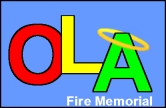
| Our Lady of the Angels (OLA) School Fire, December 1, 1958 |
July 21, 2000
BY LON GRAHNKE STAFF REPORTER
It's a myth that the nuns at Our Lady of Angels School told kids to stay at their desks and pray as fire raged through the school on Dec. 1, 1958.
That's the conclusion of Nicholas Faith, author of Blaze: The Forensics of Fire (St. Martin's Press), who focuses on the most disastrous fires in modern times.
The fire at Our Lady of Angels affected only one wing of the school, housing 329 out of 1,400 pupils, but 92 students and three teaching nuns died. And 76 other people were injured in the third-worst fire in Chicago history.
Rumors spread that the nuns had imposed a fatal inaction on their pupils, having them pray at their desks when they could have escaped.
But Faith, a journalist and writer for British television, uses forensic science to assert that the nuns and the children had no chance to escape.
The fire began in the basement at the bottom of a seldom-used back stairway on the north wing of the school, which was U-shaped with an annex connecting two wings. The fire started in a large cardboard drum. It burned undetected, and when the heat from the fire broke a window on the stairway, a rush of air spread upward, and fire caught on the wooden staircase leading to the first and second floors. On the first floor, there was a fire door that prevented the products of combustion from spreading.
But on the second floor, there was no fire door, and flames quickly ignited floors that had been varnished with oil-based soaps and waxes through decades. At the same time, the hot air and the products of combustion spread upward into the attic between the second-floor ceiling and the roof of the school.
By the time the occupants on the second floor finally sensed that something was wrong, it was too late.
In his book, Faith interviews forensic scientists and firefighters to explain other disastrous fires, such as those at the MGM Grand Hotel in Las Vegas, the Triangle Shirtwaist Factory in New York and the Kings Cross underground station in London, among others.
He also traces the history of arson and the psychology of its perpetrators and that of humans caught in fires.
| Back | Top of Page | Home |